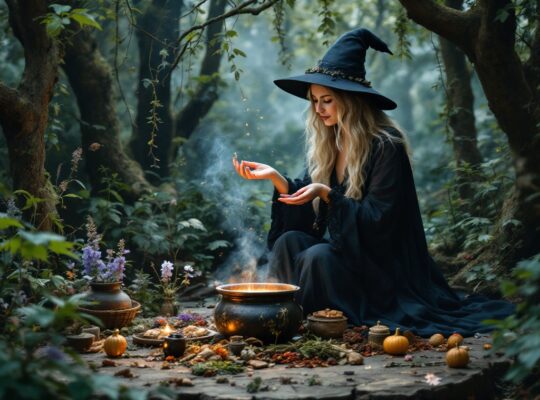Hey there, fellow seekers of the arcane! I’m ready to take you on a whirlwind tour through the captivating realm of magical books. Whether you’re a seasoned practitioner or just dipping your toes into the mystical waters, understanding the various types of magical books is crucial for any aspiring witch or wizard. So, grab your favorite brew, get cozy, and let’s dive into the enchanting world of magical literature!
Unlocking the Mysteries: An Introduction to Magical Books
Magical books have been an integral part of human culture for centuries, serving as repositories of wisdom, spells, and esoteric knowledge. These tomes come in various forms, each with its unique purpose and significance. From ancient grimoires to personal Books of Shadows, magical books have shaped traditions, inspired practitioners, and fueled the imagination of countless generations.
The importance of magical books extends beyond mere record-keeping. They serve as bridges between the past and present, allowing ancient wisdom to flow into modern practices. Moreover, they act as powerful tools for personal growth and spiritual development, helping practitioners connect with their inner magic and the world around them.
Grimoires: The Spellbinding Manuals of Magic
Grimoires are perhaps the most well-known type of magical book. These ancient tomes of spells, rituals, and magical instructions have captivated the minds of occultists and curious readers alike for centuries. The term “grimoire” comes from the Old French word “grammaire,” which originally referred to any book written in Latin.
Famous grimoires include the “Key of Solomon,” allegedly written by King Solomon himself, and the “Necronomicon,” a fictional grimoire created by H.P. Lovecraft that has taken on a life of its own in popular culture. These books typically contain:
- Detailed spell instructions
- Summoning rituals for spirits and demons
- Magical correspondences (herbs, crystals, planetary alignments)
- Mystical symbols and sigils
While historical grimoires were often associated with dark magic and demonology, modern interpretations have evolved. Today, many practitioners create their own grimoires, blending traditional knowledge with personal insights and experiences.
Book of Shadows: The Personal Chronicles of a Witch
Unlike grimoires, which are often seen as universal magical manuals, Books of Shadows are deeply personal. Popularized by Gerald Gardner, the founder of modern Wicca, a Book of Shadows is essentially a witch’s magical diary. It’s a place to record spells, rituals, dreams, and magical experiences.
The beauty of a Book of Shadows lies in its diversity. No two are exactly alike, as they reflect the unique journey of each practitioner. Some common elements you might find in a Book of Shadows include:
- Personal spells and rituals
- Herbal recipes and remedies
- Tarot or rune readings
- Reflections on magical workings
- Sabbat and Esbat celebrations
Creating your own Book of Shadows can be a profound magical act in itself. It’s a way to document your growth, preserve your discoveries, and create a legacy of your practice.
Enchanted Texts: Storybooks and Novels with Magical Properties
Moving from the realm of practical magic to the world of fiction, we find enchanted books that are magical objects in their own right. These books, often featured in fantasy literature and pop culture, possess extraordinary powers that can alter reality, transport characters to other worlds, or reveal hidden truths.
Some famous examples include:
- The Book of Thoth in ancient Egyptian mythology
- Tom Riddle’s diary in “Harry Potter and the Chamber of Secrets”
- The Enchiridion from “Adventure Time”
These fictional magical books captivate our imagination because they embody the transformative power of knowledge and the allure of hidden wisdom. They remind us that books themselves can be magical, opening doors to new worlds and possibilities.
The Alchemical Tomes: Blending Magic with Science
Alchemical texts occupy a unique space between magic and science. These esoteric works, filled with cryptic symbols and allegorical language, sought to unravel the mysteries of nature and achieve spiritual transformation.
Some of the most famous alchemical texts include:
- The Emerald Tablet
- The Rosary of the Philosophers
- Splendor Solis
Alchemical tomes are fascinating not just for their content, but for their intricate illustrations and symbolic language. Decoding these texts requires a deep understanding of alchemical symbolism and philosophy.
For a deeper dive into alchemy and its modern applications, check out our article on Alchemy in Modern Witchcraft.
Safeguarding Magical Knowledge: The Role and Responsibility of Magical Books
With great power comes great responsibility, and magical books are no exception. As keepers of esoteric knowledge, these books play a crucial role in preserving magical traditions. However, they also raise important ethical questions about the use and dissemination of magical knowledge.
In the digital age, the preservation and sharing of magical knowledge have taken on new dimensions. Online grimoires and digital Books of Shadows offer unprecedented access to information, but also raise concerns about authenticity and the loss of personal connection to magical practices.
As practitioners, it’s our responsibility to approach magical books with respect, discernment, and a commitment to ethical practice. Whether we’re working with ancient grimoires or creating our own magical texts, we’re part of a long lineage of magical knowledge-keepers.
Magical books, in all their diverse forms, are more than just repositories of spells and rituals. They’re living documents of magical traditions, personal journeys, and the ongoing dialogue between practitioners and the mystical forces they work with. Whether you’re drawn to ancient grimoires, personal Books of Shadows, or fictional magical tomes, remember that the most powerful book of magic is the one you create yourself, filled with your own experiences, insights, and magical discoveries.
So, dear witches and wizards, what magical book will you open next? Or better yet, what magical book will you begin to write?
The power is in your hands!

FAQs
Q: Can I use someone else’s Book of Shadows?
A: While you can draw inspiration from others, a Book of Shadows is typically a personal document. It’s best to create your own that reflects your unique practice.
Q: Are grimoires evil?
A: No, grimoires are not inherently evil. Like any tool, their nature depends on how they’re used. Many modern grimoires focus on positive magic and personal growth.
Q: Do I need to be able to read ancient languages to use traditional grimoires?
A: While knowing ancient languages can be helpful, many traditional grimoires have been translated into modern languages. However, understanding the historical and cultural context is often more important than the language itself.







